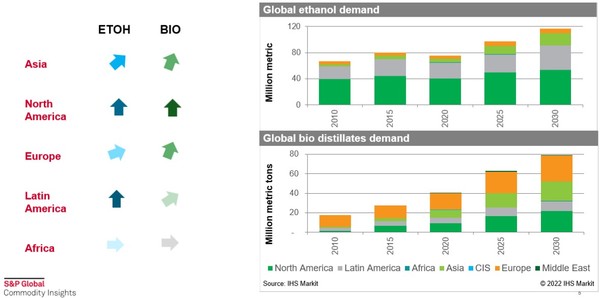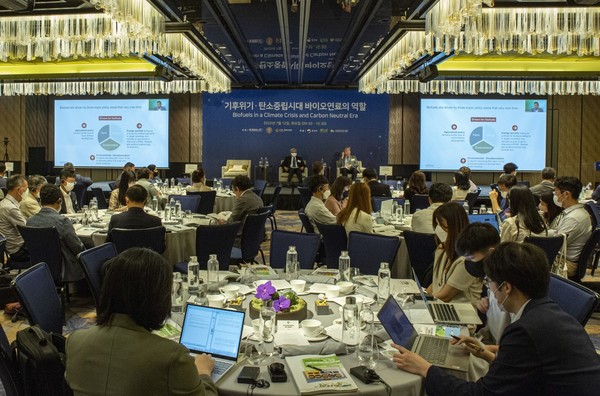Developed and developing countries such as the United States, France, India have already begun policy and development
South Korea is slow in recognition and direction even though it is low in terms of renewable energy
[Four Seasons Hotel=The Hwankyung Ilbo] Hyun Jin Lim Reporter = Following the opening of the "Biofuels in a Climate Crisis and Carbon Neutral Era International Symposium", experts from the U.S., France, the Philippines, and India participated to present global carbon neutrality, outlook, and plans.

There are three essential pillars in establishing biofuel policies internationally: agricultural economic development, energy security, and decarbonization.
The global biofuel market has slowed down from 2009 to 2018, but production increased in 2019. This supply situation once led to a drop in the prices of ethanol and biodiesel. Demand for biofuels is expected to continue to increase due to various policies such as increasing global fuel demand, biofuel mixing obligations, and subsidies.
The need to look at the present and future situation of biofuels in terms of institutions has been raised because international prices of biofuels are actually closely linked to changes in supply materials and transportation prices rather than technology.
Global Carbon Neutrality/Biofuel Policy continues to be implemented

"The policy of biofuels is complex," said Mr. Juan Sacoto, director of S&P Global Community Insights. Agricultural development, energy security, and the environment can be seen as the main pillars.
He said that in most cases agricultural development is the key, but in the case of the EU, the exception was left open. This is because the proportion of agricultural role-based policies is gradually decreasing, and the use of corn, wheat, and palm oil as raw materials for biofuels tends to decrease or disappear.
"Regarding energy security, Indonesia, Malaysia, and the Philippines are pushing for biofuel policies. North America and Europe placed great importance on energy security ten years ago, and energy security has been re-emphasized due to the recent Russian-Ukraine crisis.
Ethanol is considered a successful policy, especially in Brazil and Latin America. Other countries also substantially use ethanol, but it is not as much as Brazil. Brazil has the most significant proportion of ethanol, with a mixing ratio of nearly 30%. Next is North America, where the ethanol mixing rate remains at 10%. Europe is about 6.5 percent. This mixing ratio also increased in Asia, with ethanol mixing levels exceeding about 2%.

Director Sacoto said, "Asia has a mixing ratio of around 2%, but it is on the rise," adding, "Other regions are still receiving limited ethanol use and insufficient support in terms of policy incentives. Therefore, there is not much supply and consumption," he said.
The three significant regions of biodiesel production are North America, Europe, and Latin America. Except for Latin America, the mixing ratio is similar, and all recorded a mixing ratio of 5.5 to 6.5 percent last year.
The biodiesel mixing ratio in Asia is close to 2%, like ethanol. In most cases, Indonesia and Malaysia lead the high mixing ratio. Indonesia has a biodiesel mixing ratio of about 30%, which means that it is a big foundation for spreading biodiesel.
"Asia has an optimistic view, although its policy is not as strong as North America or Latin America," he said. "Jet fuel is shifting to biofuels and new demand markets in the EU, Canada, and Asia. SAF (Sustainable Aviation Fuel) policies to support more demand for ethanol worldwide should be the basis, and high barriers and frequent policy interventions should be prevented from hindering trade flows," he advised.
Active in regulating and supporting the U.S., the largest producer, consumer, and exporter of ethanol

The U.S. enacted the Renewable Fuel Standard (RFS) through the U.S. Congress since 2005, and expanded and revised it to purify air quality in 2007. The law mandates ethanol mixing for gasoline on a volume basis. It has been said that it will continue after 2022.
This is a relatively strong mandatory measure in the United States. RFS is implemented by the EPA, which reflects the opinions of the Department of Agriculture and the Department of Energy in the process. One of the critical purposes of RFS is greenhouse gas reduction, which is aimed at reducing gas emissions in the distribution sector and reducing dependence on imported oil.
The United States allows 15 billion gallons of corn starch-based ethanol. Currently, 95 to 98% of all gasoline sold in the United States is E10 ('E' means ethanol, 'number' is mixed with gasoline), and some E15 and E85 are sold. The increase in ethanol usage was rapidly expanded through RFS. Even before that, ethanol mixing had been going on for decades.
In addition to the federal government, various policies have been introduced at the state level. For example, in the case of California, low-carbon fuel standards were introduced in 2010, Oregon applied for a clean fuel program in 2016, and Washington used a similar project in 2021.

"The U.S. is adopting an active support policy to increase ethanol use as well as regulations," said Emily Marshall, an international trade expert at the U.S. Department of Agriculture. "If companies that want to use more ethanol and E10 need additional storage facilities and pumps, the federal government subsidizes them."
"The E15 has been approved since 2011 for non-variable fuel engines. This applies to vehicles manufactured after 2001, about 93% of all lightweight vehicles, he added. "President Biden has announced plans to make 50% of new U.S. vehicles electric by 2030. On top of that, there are many challenges to solve, such as batteries and internal combustion engine engines, but we will gradually solve them."
"In addition, ethanol can benefit consumers by reducing greenhouse gas emissions and strengthening competition among gasoline companies. The expansion of ethanol use is more of a regulatory problem than a technical problem," he said, stressing the importance of regulation.
Regarding biofuels, Marshaller, an international trade expert, predicted that "energy security, diversification of supplies, new expansion in trade, and reduction in oil prices could not only reduce vehicle combustion but also help reduce lifecycle emissions."
Commercialization of French Biofuels through the 'Sub-Tax System'

France is also expected to strengthen its policy in the future regarding mandatory biofuels. This is because the internal renewable energy guidelines stipulate that the proportion of renewable energy in the transportation sector will be 14% by 2030.
As a result, in France, bioethanol and biodiesel targets have been gradually raised over the past five to six years. Moreover, France's E85 price is competitive as a result of a "substantial taxation system" based on carbon efficiency of fuel efficiency.
Looking at the current situation in France, tax systems such as incentives for related biofuel mixing are being promoted, and penalties are also being applied if fuel suppliers do not comply with the mandatory fuel supply.
In 2022, the consumption tax for petroleum products (TICPE) was set at 67.02//hl for E10, 69.02//hl for E5, and 11.83//hl for E85. Conversely, the tax (TIRIB) payable by suppliers who do not comply with renewable regulations is 101//hl.
In this case, the tax imposed on E85 is relatively low, which reduces gas station sales prices. In addition, the Russian-Ukraine crisis has affected Europe, and Ukraine is a significant supplier of grains such as corn and wheat.
As grain supply was disrupted, supplies to Europe decreased, and prices rose accordingly. This situation is also burdening biofuel producers' margins. In the case of France, most of the ethanol raw materials used are grain-based materials, with 62% being grain, followed by sugar beet, accounting for 15%.

Monika Rajoria, a biofuel expert at S&P Global Community Insights, dismissed concerns about the war situation and said, "Ukraine imports only 8 percent. Most of the raw materials, which account for 80%, are produced by France. Therefore, it is an advantageous structure for fuel production concerning the supply of raw materials," he said, judging the situation of biofuels in France.
S&P Global expects fuel ethanol consumption to exceed the pre-pandemic peak in 2022. European ethanol supplies vary in grain (corn, wheat) and sugar beet; imports of EU ethanol in 2021 will be about 900 million liters. In addition, the EU-27 and the UK have 10 billion liters of installed production capacity.
"France is the largest ethanol producer in the European Union, followed by Germany," said Rajoria, adding, "Soon, the rapid growth of biofuels through availability and reasonable prices will promote E10 and E85 consumption."

Optimal, raw materials, and availability of bioethanol production processes in the Philippines ↑

The Philippines, a developing country, also saw the possibility of biofuels early on. Like Europe and advanced countries, the Philippines enacted the "Biofuel Act" in 2006, called the Republic Act 9367, to reduce dependence on energy mix, and imported fossils, improve the quality of the environment, and improve the economic development of rural communities.
Under the Biofuel Act, the National Biofuel Commission shall review and recommend to DOE the adjustment of the minimum mandatory biofuel mixture according to the availability of locally sourced biofuels. After that, it includes contents such as 'Bioethanol and biodiesel do not lower the minimum mixing ratio of 5% and 2%, respectively.'
The government recognizes 13 bioethanol producers in the Philippines. Annual production is 463 million liters, equivalent to 60% of the obligation rate. Domestic bioethanol sales reached 357 million liters in 2021.
Ruby B De Guzman, director of the biomass bureau at the Philippine Energy Agency, said, "We expect to add about 38 million liters of production capacity this year, increasing the total capacity by 501 million liters by the end of the year." This will be possible by improving the production process's optimal raw material and supply availability," he said, specifying the expansion of bioethanol and production targets in the Philippines. He also said, "We plan to continue to build a regional-based bioethanol industry and conduct feasibility research and development of aqueous bioethanol."
India "Focuses on Bioethanol to Address Economic and Environmental Crisis"

India's oil imports account for about 90 percent of domestic consumption. Gasoline consumption is steeply rising, with improved economic and transportation infrastructure and public and private transportation options.
Ashok Pandey, a senior researcher at India's Center for Innovation and Transformation Research, said, "Our crude oil import bill doubled to $119 billion in fiscal 2021-2022. India also signed the Paris Agreement and promised to reduce the carbon footprint of our economy by 33-35% compared to 2005. 40% of installed electricity capacity should be newly reorganized by 2030," he said, explaining the background of the policy implementation on biofuels.
"India's program for ethanol mixing is important to deliver on its economy and its commitment to climate change behavior," said Pandey, a senior researcher. "We are currently focusing on building capacity for first-generation distilleries and achieving the 2025 goal of mixing 20% ethanol through the same sugar and grain materials."
"India's Ministry of Oil and Natural Gas estimated that implementing a 20 percent ethanol mixture in gasoline would save up to $4 billion a year. Unlike biodiesel, bioethanol feedstock is vast and diverse. It includes first and second-generation sources, molasses, sugarcane, grains and tubes, and lignocellulose biomass," he said. "Farming residues are also effective 2G supplies. This is because agricultural residues are abundant in the state, he explained.

The Indian government has changed several policies on biofuels since 2018. First, it expanded the scope of raw materials for bioethanol production by using sugar cane juice, sugar beet, sugar cane, corn, cassava, complete classification, wheat, damaged food grains, broken rice, and rotten potatoes.
It also allowed surplus food grains to be used in the production of bioethanol to be mixed with gasoline, with the approval of the National Biofuel Coordination Commission. This will enable farmers to get the right price for surplus agricultural products.
"The Indian government is trying to increase the viability of second-generation bioethanol refineries, plus additional tax incentives, which are reasonable compared to first-generation biofuels," Pandey said.

We will make sure that the purchase price is measured, he said. "We have already launched second-generation ethanol for EBP, and 12 factories centered on OMC (World Trade Organization) have begun various developments."
Professor Kim Jung In of Chung-Ang University, who lead the presentation, said, "I think having various feedstock will play a crucial role in the development of biofuels in the future," adding, "I hope that this symposium will lead to smooth communication with the industry, officials, and the public."

